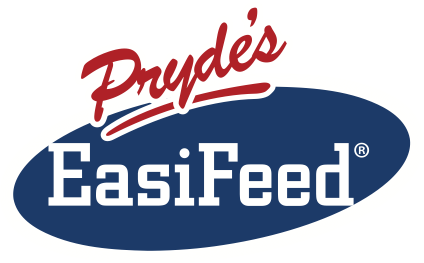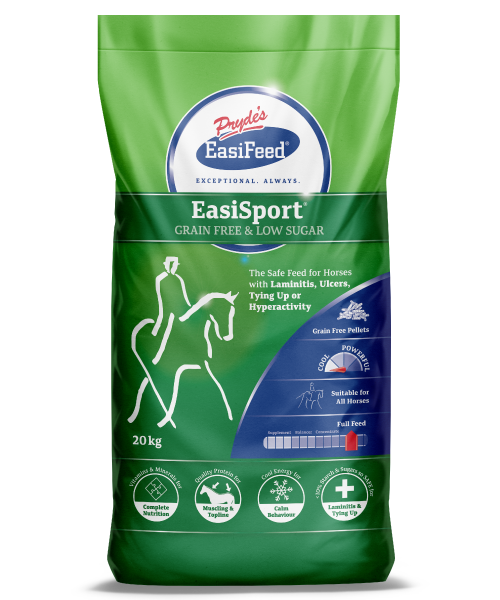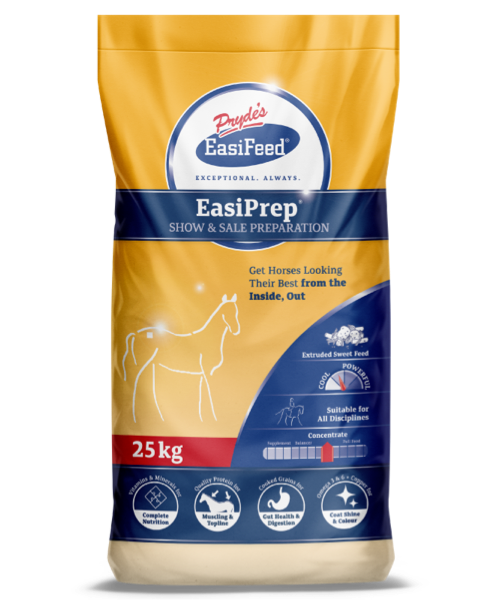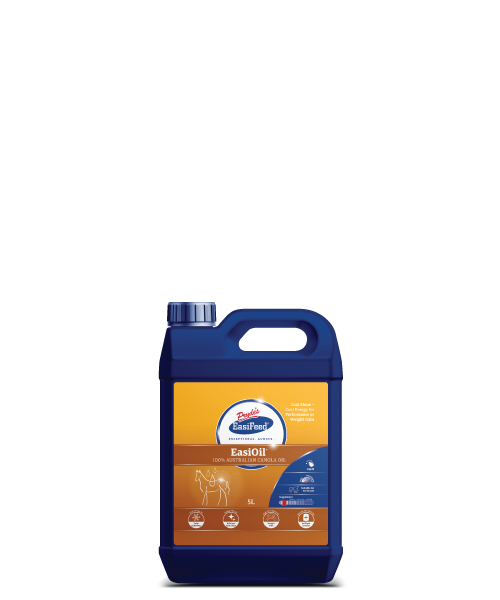Keeping stallions ‘Safe & Sound’
Dr Nerida Richards
A lot of effort goes into providing stallions with safe yards, boxes and work environments and justifiably so to protect them from external injuries. But what about internal problems? You only have to Google ‘stallion dies colic’ or ‘stallion dies laminitis’ to realise just how many stallions have been lost over the years to nutrition related diseases. And look in almost any feed room at a stallion barn and you will find a host of supplements for hoof problems. It stands to reason then that providing a ration that will reduce the risk of colic and laminitis and keep hooves healthy is equally as important as the safety of a stallion’s external environment.
Tips for feeding to avoid Colic
Colic takes on many forms and can be caused by so many things. Even if you are feeding the best diet in the world there is still a chance a horse will get colic. But feeding the right ration in the right way can substantially reduce the risk of colic occurring. Tips for feeding to avoid colic include:
1. Feed plenty of fibre - Most stallions get some turnout time, but when they are in their boxes they should be given access to as much grassy/pasture hay as they want. Some lucerne hay can be fed but avoid feeding only lucerne hay as this can cause its own set of issues.
If you have a fussy or distracted stallion that won’t eat hay, use chaff instead, being careful to weigh and feed chaff amounts accurately (a 2L dipper of chaff weighs ≈ 250 grams).
Broad recommendations suggest that a horse should be fed a minimum of 1 kg of forage for every 100 kg of bodyweight but the more forage you feed the safer a diet will be, so feeding closer to 2 kg of forage (hay or chaff) for every 100 kg of bodyweight (12 kg/day for a 600 kg stallion) is where I would be aiming for a stallion receiving very little turnout time.
2. Keep an eye on water intake – Some horses aren’t good drinkers all of the time while other horses may temporarily stop drinking due to illness, pain, electrolyte deficiency or a problem with the taste or temperature of the water. Whatever the cause, dehydration is a major risk factor for colic and as such water intake should be closely monitored. Where automatic waterers are used a flow meter should be considered.
If you notice a horse isn’t drinking try to isolate the cause and do everything you can to get water intake back to normal as quickly as possible. Where there is no obvious cause, additional salt can be added to the ration to increase a stallion’s thirst response and subsequent water intake.
3. Feed Cooked Grains – Anything that disrupts the fine balance that exists in a stallion’s hindgut between populations of good and not so good bacteria puts that horse at risk of colic. Feeding whole or crushed cereal grains like barley or corn to stallions will see large amounts of undigested starch being delivered to the hindgut which in turn results in the production of excessive amounts of volatile fatty acids, lactic acid and gases, all of which can lead to colic. Feeding grains that have been cooked (extruded, micronised or steam flaked) ensures the grain starch is digested in the small intestine where it should be digested and keeps the hindguts ‘balance’ in check.
Tips for feeding to avoid Laminitis
Laminitis can be caused by many things, but two of the most common causes in otherwise healthy horses are hindgut acidosis and insulin resistance. Tips for feeding to avoid laminitis include:
1. Feed Cooked Grains – As discussed above, feeding whole or crushed cereal grains including barley or corn to stallions causes large amounts of undigested starch to be dumped into the hindgut where it is rapidly fermented by bacteria. This rapid fermentation causes a build up of volatile fatty acids and lactic acid. These acids drop the pH within the stallion’s hindgut and lead to a condition known as hindgut acidosis. Stallions with hindgut acidosis are at risk of developing sub-clinical or acute laminitis. Cereal grains with the exception of oats should NEVER be fed to a stallion uncooked.
2. Control body fatness – Stallions that are overfed and become overweight may develop a condition known as insulin resistance where their body needs to release massive amounts of insulin to keep blood glucose levels under control. It is now known that higher than normal levels of insulin are a cause of equine laminitis. To prevent insulin associated laminitis, stallions should be kept active, fit and in good but not excessive body condition.
Tips for feeding to improve Hoof Quality
While your farrier is going to have a major influence on a stallion’s hoof health, much of what determines how strong and healthy a stallion’s hooves are is controlled by nutrition. Tips for feeding to improve hoof health include:
1. Feed plenty of forage – The bacteria in a stallion’s hindgut are largely responsible for producing the B-vitamin biotin which is needed for good hoof growth. To maximise biotin production, the bacteria in the hindgut need to have access to plenty of forage (fibre) to ferment to allow them to produce biotin. As discussed above, you should aim to feed up to 2 kg of forage (hay or chaff) for every 100 kg of bodyweight (12 kg/day for a 600 kg stallion) for a stallion receiving very little turnout time.
2. Feed cooked grains – again this is important! Feeding uncooked grains disrupts the populations of bacteria in the hindgut that are responsible for biotin production so if you feed uncooked grains and cause any level of hindgut acidosis, biotin production and hoof health can be negatively affected.
3. Feed high quality protein – Strong hooves rely heavily on a good source of essential amino acids and particularly methionine. Choose feeds for your stallions that are based on high quality proteins that are naturally high in methionine like black sunflowers (8.8 g methionine/kg) and soybean (6.5 g methionine/kg).
Feeding High Risk Horses
Some stallions are more prone than others to colic, laminitis and/or hoof problems. These stallions need to have their diets closely managed and would benefit from being fed a high fibre, grain free ration. Grain free diets reduce the risk of colic and insulin related laminitis, they remove the risk of hindgut acidosis related laminitis and help to improve hoof quality in stallions struggling with hoof problems. Stallions with hoof problems may also benefit from additional biotin supplementation.
Grain free diets also benefit highly strung stallions as they tend to help keep them a little more ‘together’ mentally and they can be safely used for stallions prone to tying up. Grain free diets should use high energy fibres like lupin hulls, unmolassed sugarbeet pulp, soybean hulls and high quality vegetable oils in place of the more traditional grains and grain based feeds used in most rations.
Prevention is better than cure
Manage your stallion rations carefully, ensuring they contain well cooked grains, high quality protein and LOTS of forage and keep a close eye on water intake and body condition to dramatically reduce the risk of an ill-fate caused by colic, laminitis or hoof problems. While a stallion can be lucky and recover from these problems, prevention is always better than cure when it comes to keeping stallions ‘safe and sound’.
The Pryde’s EasiFeed range of quality feeds includes EasiPrep Concentrate (an extruded grain based sweetfeed concentrate with high quality protein and black sunflowers), EasiSport (a non grain complete feed based on lupins hulls and soybean protein) and Polished (a biotin, methionine and organic mineral hoof and coat supplement) giving you a complete feed range that can cover your stallion needs.
These feeds provide you with safe, high quality options that will reduce your stallions’ risk of colic and laminitis and help to correct hoof problems.
Pryde’s recommend the following diet for breeding thoroughbred stallions not at increased risk of colic or laminitis.
RISK OF COLIC
RISK OF LAMINITIS
* Pasture Hay can be reduced with turnout time
These diets are formulated based on a 600kg stallion covering up to 100 mares per season. Stallions with hoof problems can have 150g / day of Pryde's Polished added to their diet.
Breeding stallions are individuals so for a full assessment of your breeding stallion needs and a custom diet formulation, contact Pryde’s EasiFeed on 1300 732 267 or email info@prydes.com.au.
Feeding The Breeding Stallion
It is the time of year again when breeding stallions are ramping up for the season that lies ahead. While maintenance of fertility is of utmost importance in the care of breeding stallions, they must also be kept looking their best, sound, energetic and disease free. As with many aspects of horse care, a holistic approach is required to achieve these goals, but as always, good nutrition provides the foundation for maintaining fertile and healthy stallions that look stunning.
Maintaining fertility
A stallion’s level of fertility is affected both by his genetics and his past and present environment. Good nutrition will never be able to make an infertile stallion fertile. However poor nutrition may limit an otherwise fertile stallion’s effectiveness in the breeding barn. To maintain maximum fertility in your stallions, a balanced diet that meets his energy, protein, vitamin and mineral requirements must be fed. Using a well formulated concentrate feed or a balanced vitamin and mineral supplement together with high quality forage is generally all that is needed to meet requirements.
Ensuring the diet is well fortified with antioxidants is essential for maintaining maximum fertility. A recent study by Contri et al (2011) found that stallions supplemented with 1500 mg of vitamin E, 2.5 mg of organic selenium and 360 mg of zinc per day had improved sperm characteristics including increased average path velocity, straightness, improved membrane integrity, progressive motility and reduced numbers of sperm with abnormal morphology.
The omega 3 to omega 6 ratio in the diet may also have some bearing on the fertility of stallions, with the dietary ratio of these fatty acids affecting the consequent omega 3 to omega 6 ratio present in sperm. Sperm with more of the omega 3 fatty acid docosahexaenoic acid or DHA appear to have a higher fertilising capacity and semen quality than sperm with higher concentrations of the omega 6 fatty acid docosapentaenoic acid or DPA. High forage, low grain diets contain more omega 3 than omega 6 and give stallions the best natural chance of having sperm with more omega 3 fatty acids.
How do I look?
Stallions need to look their best to attract the mare owner’s eye. By the time a stallion reaches breeding age nothing can be done to change overall conformation, but muscling and topline, coat shine and a fit but well conditioned appearance can all be manipulated through nutrition. And again, feeding a well balanced diet that contains high quality protein for maintaining muscle mass, oils with both omega 3 and 6 fatty acids for coat and skin health and a full array of vitamins and minerals will keep stallions looking their best.
Staying sound
Breeding like most physical activities promotes a degree of wear and tear on a stallion’s musculoskeletal system. Diet has a huge impact on the health of a stallion’s joints and bones. Trace mineral and vitamin deficiencies as well as low quality protein in the diet can contribute to joint and bone degeneration. While many stallions are supplemented with equine joint formula’s as a preventative strategy, using joint supplements can only be effective if they are fed in conjunction with a well balanced diet that is meeting requirements for protein, vitamins and minerals.
The ratio of omega 3 to omega 6 fatty acids in the diet may also play a role in joint health, with high omega 6 diets tending to aggravate joint inflammation. High grain diets that are high in omega 6 fatty acids should be avoided for stallions in preference to forage dominant diets higher in omega 3.
Staying healthy
All too often good stallions are lost to colic or laminitis. While there are many causes of both these diseases, some are easily avoided through good nutrition. The risk of both colic and laminitis can be lowered by feeding a high forage, low grain diet, where an absolute minimum of 1% of bodyweight (1 kg/100 kg of bodyweight) is fed per day of forage. A preferable minimum forage intake is closer to 1.5% of bodyweight which will ensure a well filled and hydrated gut environment.
In addition, where grains are fed, only cooked and very digestible grains should be fed to stallions to lower the risk of undigested grains entering the hindgut where they will be rapidly fermented, causing acidosis. Hindgut acidosis is known to cause both colic and laminitis.
To keep stallions healthy they should not be allowed to become sedentary and overweight or obese as this also increases the risk of insulin resistance and laminitis and also increases joint wear and tear. The maintenance of a regular exercise program and a moderate to good body condition will keep insulin sensitivity high and the risk of insulin induced laminitis low and reduce the stress placed on their joints. Regular exercise will also help to keep stallions fit and better able to cope with a rigorous breeding schedule.
How much to feed
How much feed a stallion needs on a daily basis to maintain the desired body condition is going to depend on the individual stallion, whether he is exercised, how much voluntary exercise he does, how many mares he covers in a season and what his maintenance energy requirement is. Some stallions are constantly on a diet while others are almost impossible to keep enough weight on.
As such, the amount you feed each day depends on the stallion. For stallions that maintain their weight easily, a forage based diet (pasture and/or hay) supplemented with a high quality forage balancer pellet fed at less than 1 kg/day with a small amount of oil to assist with coat shine may be all he needs. For stallions that need a higher energy diet to hold their weight, a well formulated and fully fortified complete feeds can be used to increase their energy intake. Stallions should be fed enough to maintain them at a condition score of 6 (on the Henneke 1 to 9 scale) where their ribs cannot be seen but are easily felt with light to moderate pressure.
When formulating stallion diets it is always a good idea to maintain flexibility by having at least one component of the diet that you can increase or decrease according to the stallions energy needs on a day to day basis without messing up the balance of the diet. For example if you have a base diet that consists of 3 kg of concentrate feed that contains all of the high quality protein, vitamins and minerals, including anti-oxidants the stallion needs, you can then have a high energy feed like cooked corn, barley, oats or a high energy fibre that can be increased or reduced in the diet according to how a stallion is looking or feeling each day.
Feed with care
As stallion owners are well aware, stallions are valuable animals and as such they need to be fed with utmost care. Have your stallion rations evaluated by a professional nutritionist, weigh feed ingredients to ensure they are fed accurately and know how to adjust the diet safely to cater to an individual stallions needs without unbalancing the overall nutrient profile. Make sure nutrients important for fertility, including antioxidants are fed at optimum levels and perhaps most importantly of all, don’t forget the forage. Failure to accurately feed enough forage may put your stallion at a higher risk of colic and could exacerbate fertility and joint issues. The more pasture and hay your stallion gets, the better.
The Pryde’s EasiFeed range of quality feeds includes EasiPrep Concentrate and ReBuild. These feeds are perfect to be fed in combination to working stallions to provide a high energy, yet safe diet that contains all of the quality protein, antioxidants, vitamins and minerals a stallion needs for maximum fertility, good health and an eye-catching appearance.
Pryde’s recommend the following diet for breeding thoroughbred stallions. The diet is formulated based on a 600 kg stallion covering up to 100 mares per season.
FEEDING WITH CARE
* Pasture Hay can be reduced with turnout time
Breeding stallions are individuals so for a full assessment of your breeding stallions needs and a custom diet formulation, contact Pryde’s EasiFeed on 1300 732 267, email info@prydes.com.au.
Dr Nerida Richards
Equilize Horse Nutrition Pty Ltd









